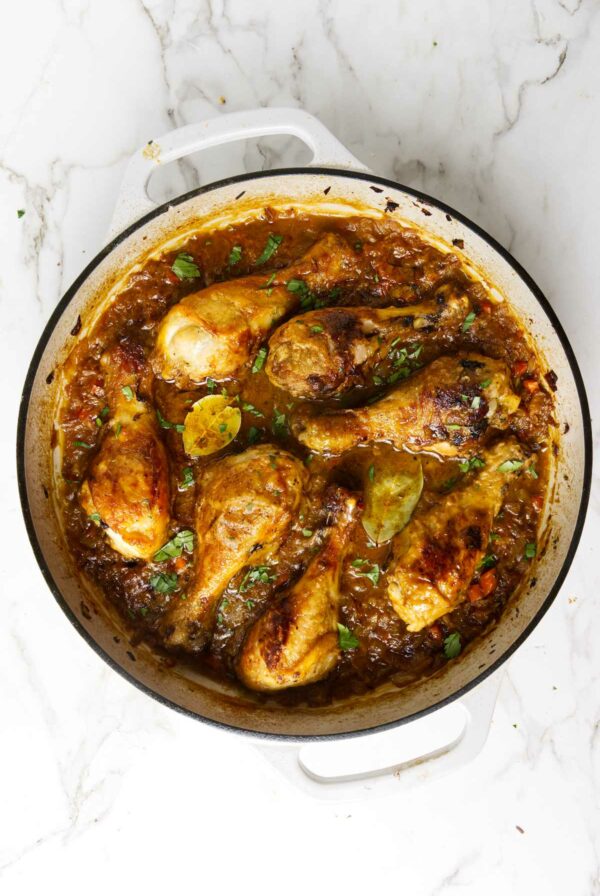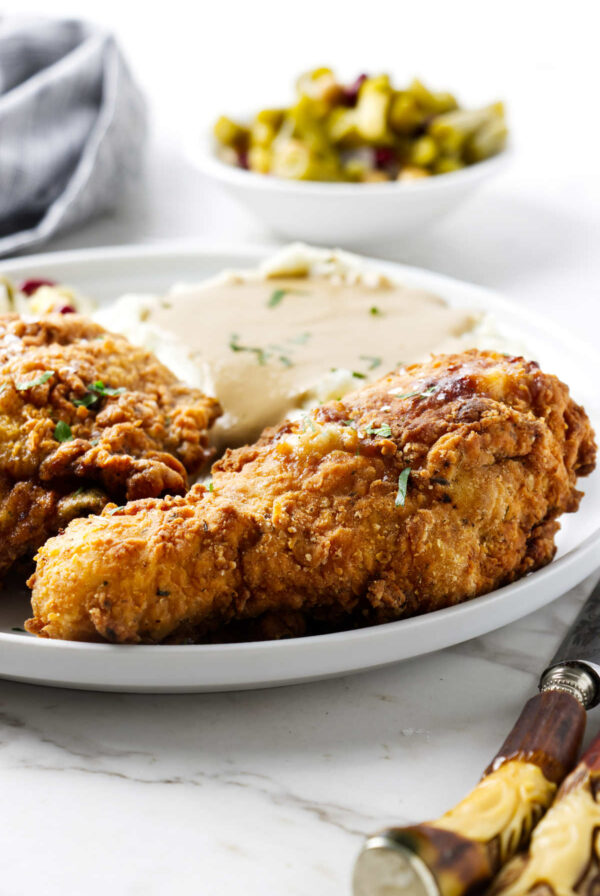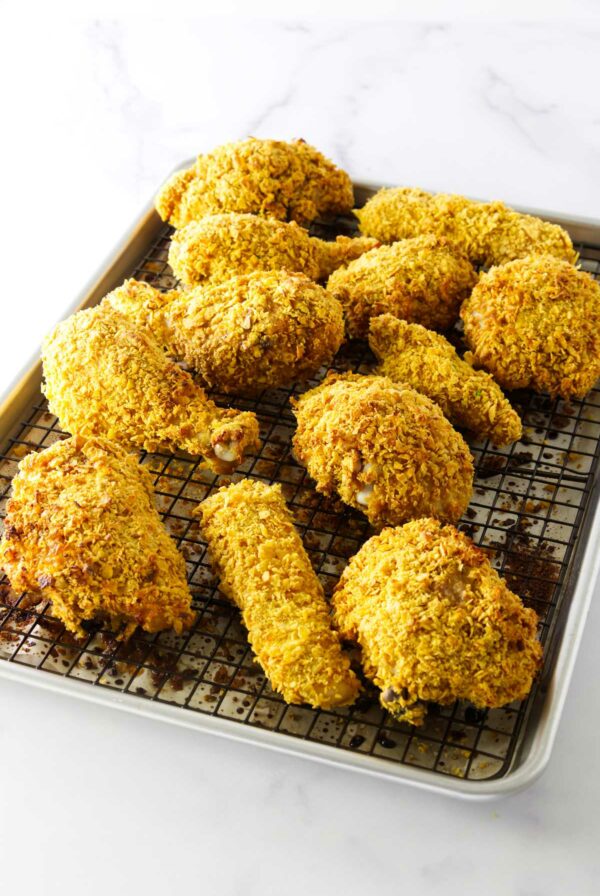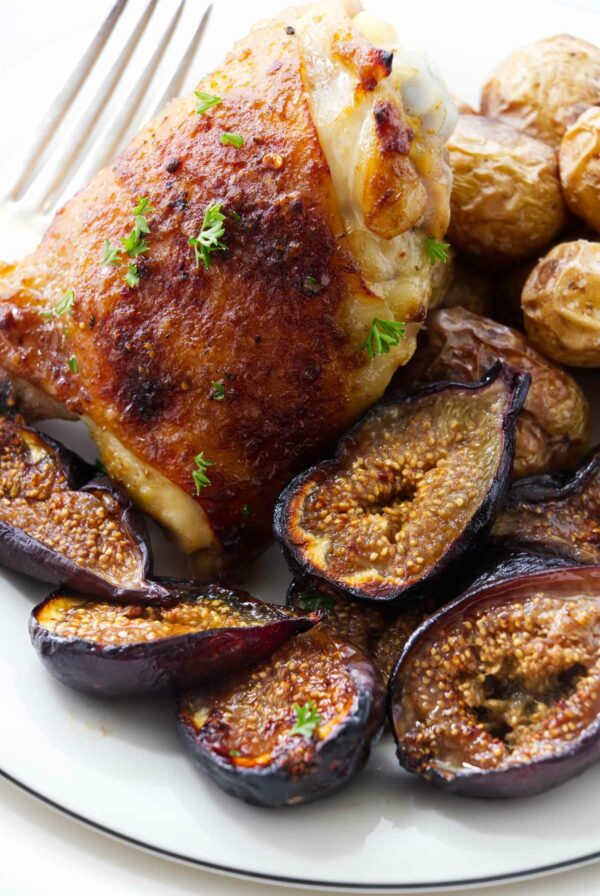This post may contain affiliate links. Please read our disclosure policy. As an Amazon Associate, I earn from qualifying purchases.
Our Traeger smoked turkey is flavored with a dry brine and injected with a savory turkey injection. The result is a juicy, flavorful, and perfectly seasoned bird that is sure to be the star of your holiday feast!
Smoking a turkey on a pellet grill is the perfect way to get juicy, flavorful meat infused with the smoky flavor of wood pellets.
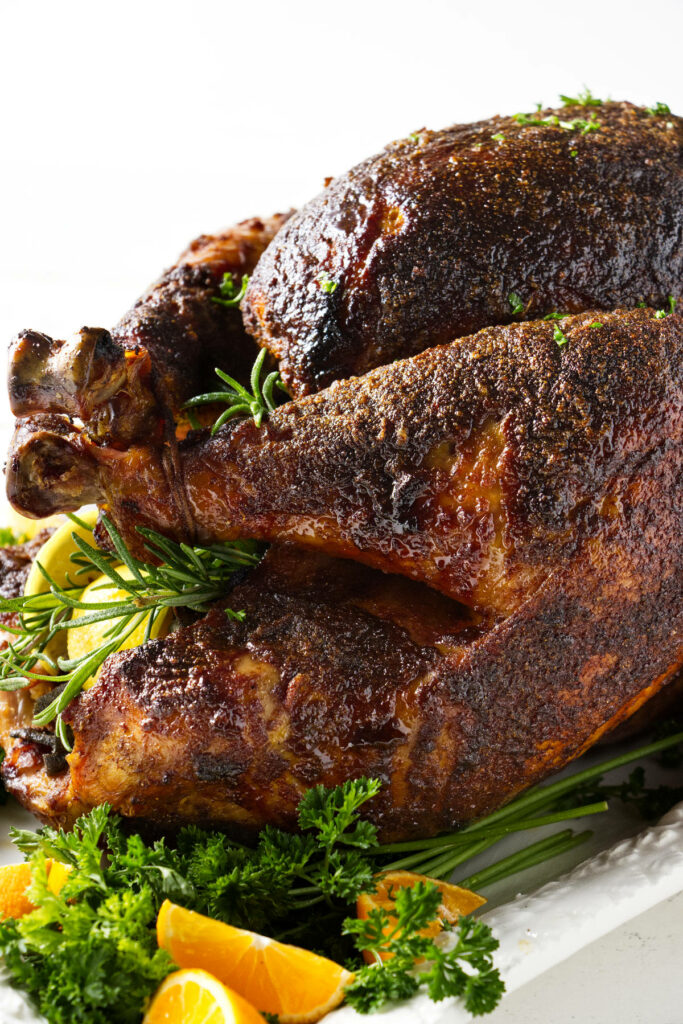
One of the keys to a great smoked turkey is in the brine. A brine allows the flavors to really penetrate the meat and results in a juicier, more flavorful bird. We used a dry brine which means there is no water involved, just salt, sugar, and spices.
We took the flavor a step further and used the dry brine spices to make a marinade to inject the turkey and baste it while it cooked on the smoker.
Here is Why This Recipe Works
- The dry brine saves a lot of space in the fridge and is less messy than a traditional wet brine.
- The marinade makes enough to use as a turkey injection and baste the turkey during the smoke.
- The salt in the dry brine helps break down the muscle fibers and allows them to retain moisture. A further bonus is that the flavors of the spices penetrate the meat. This results in a juicier bird with more flavor.
- Cooking a turkey on a pellet grill frees up the oven for all the other sides and gives the turkey a delicious smoky flavor. The marinade injects even more flavor into the bird and keeps it moist while it smokes.
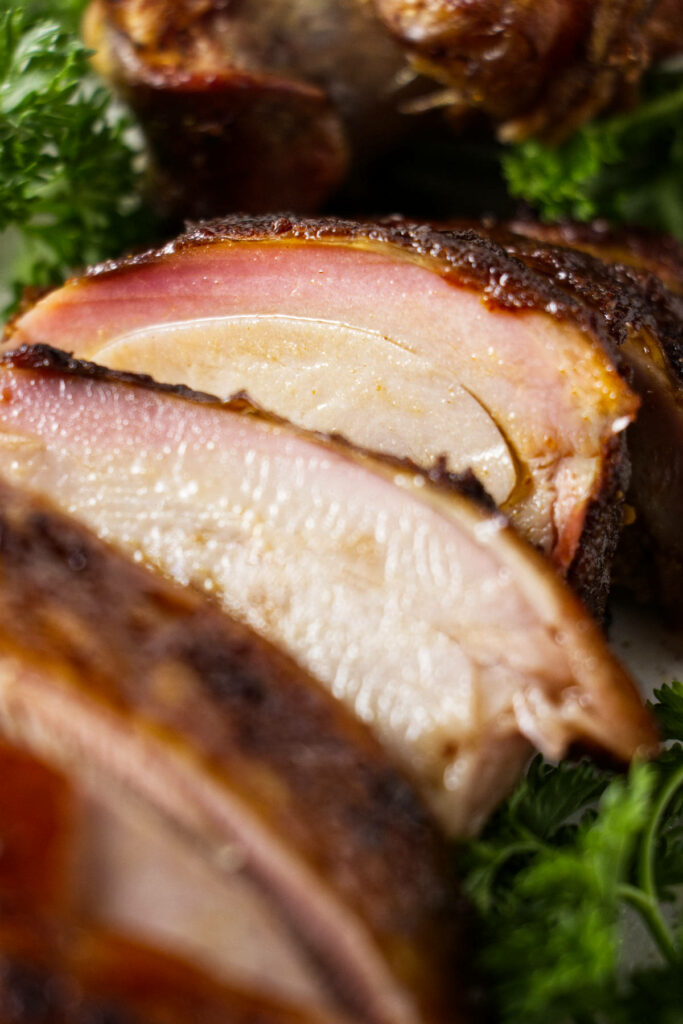
The Ingredients
Here is a list of the ingredients you will need for this Traeger turkey recipe. Scroll down to the printable recipe card for all the details.
For the Dry Brine
- Brown sugar.
- Kosher salt.
- BBQ Seasoning Rub. You can make your own bbq seasoning blend or purchase your favorite brand.
The Turkey Injection and Basting Sauce
- Dry rub. If you use a seasoning blend with large particles of herbs, crush them finely with a mortar and pestle, so they don’t get clogged in the syringe.
- Vinegar. We used apple cider vinegar.
- Butter. You can use salted or unsalted butter.
- Olive oil. The olive oil adds additional fat and prevents the buttery injection from solidifying.
- Honey. If you don’t have honey, maple syrup will work.
- Worcestershire sauce. Adds a bit of umami flavor.
- Hot sauce. We like the flavor of Tabasco sauce, but any hot sauce will work.
- Salt.
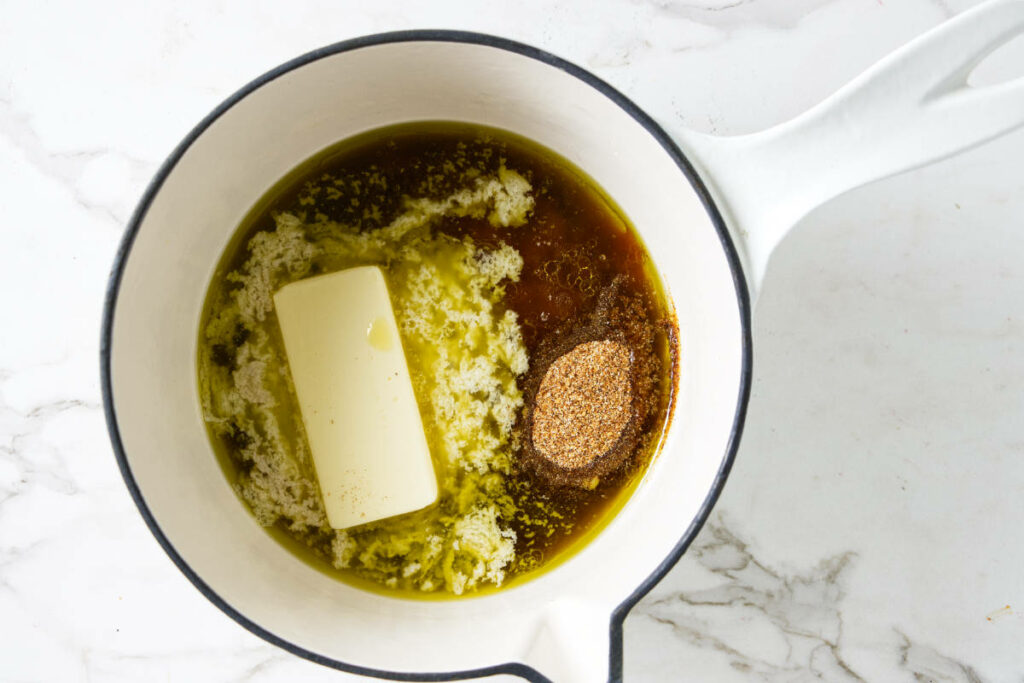
For the Turkey
- 1 whole turkey. Since this Traeger smoked turkey has salt in the dry brine and injection marinade, start with an unseasoned turkey. If you use a Kosher or self-basting turkey, your turkey will be excessively salty.
- Aromatics. We used onion, garlic, lemons, and fresh herbs to stuff inside the cavity of the turkey.
Smoking a Turkey on a Pellet Grill
Here is a brief overview to get an idea of what to expect with this Traeger smoked turkey. Scroll down to the printable recipe card for all the details.
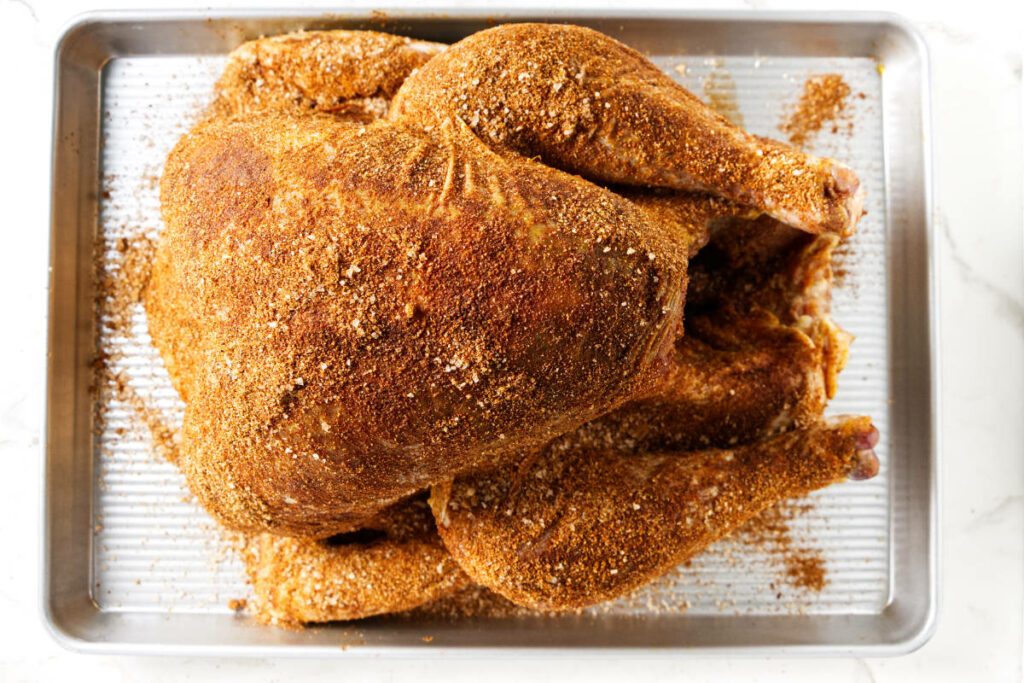
- Mix the dry brine. Cover the whole bird with the brine mixture and make sure to get under the skin and inside the cavity.
If you don’t want to take the time (or don’t have the time) to brine the turkey, you can skip this step
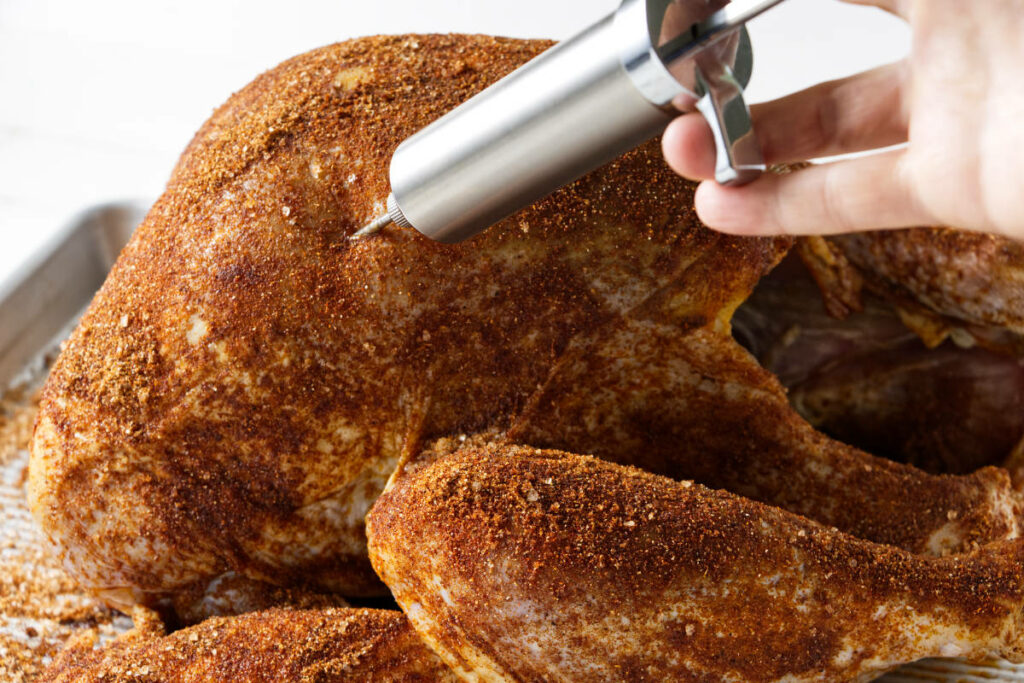
- Inject the turkey. Mix the injection marinade and reserve some of the mixture for basting the turkey while it smokes. Draw the rest of the liquid into a turkey injector and inject the bird into the breast, thighs, and legs.
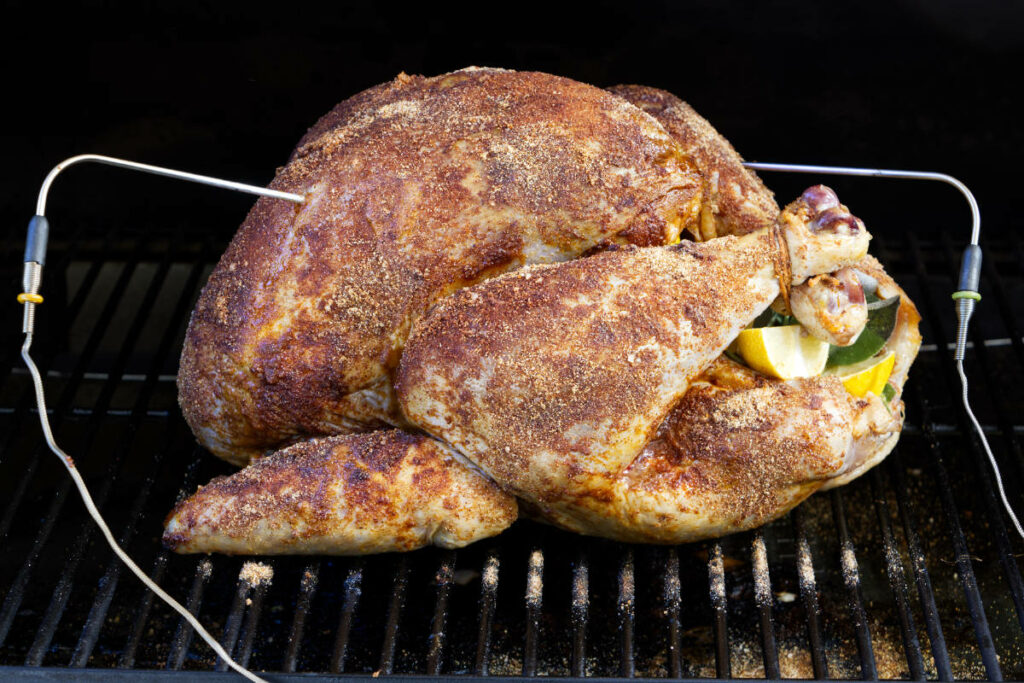
- Smoke the turkey. Place the turkey directly on the grill grates and place a leave-in meat thermometer in the thickest part of the breast meat.
You can place the turkey in a roasting pan if you want to collect the drippings.
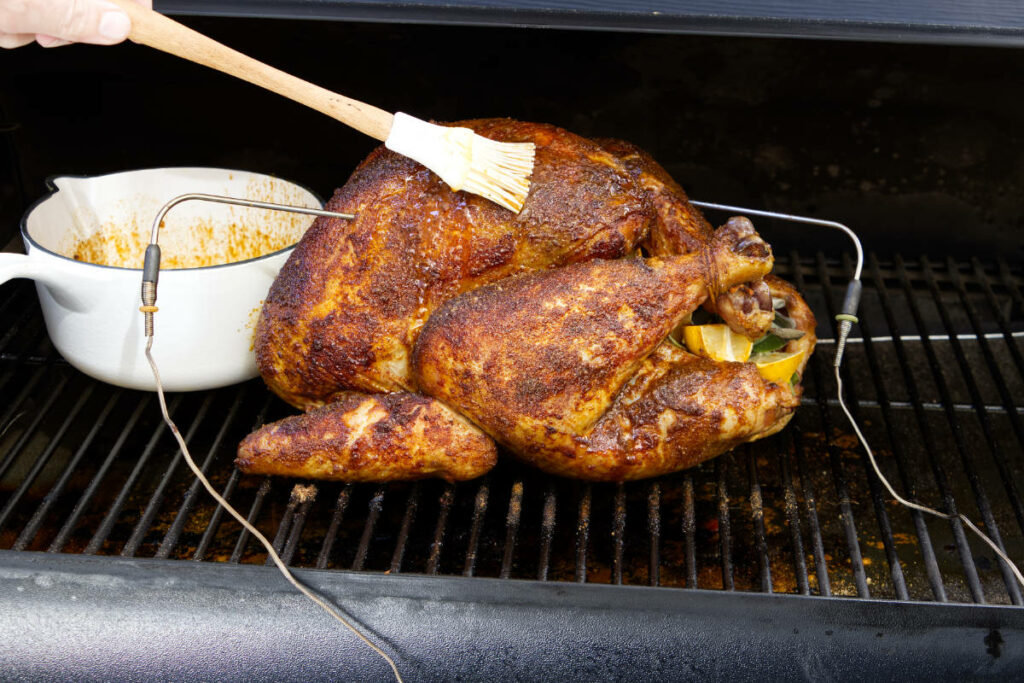
- After the turkey smokes for an hour, use the basting sauce to baste the bird every 45 minutes.
More Grilling Recipes
- Traeger Smoked Baked Potatoes
- Smoked Whole Chicken
- Traeger Pork Shoulder
- Smoked Beer Can Chicken with Gravy
- 35 Grill Master Traeger Recipes
Tips for Success
- Brine the turkey for 72 hours if you have the time. A dry brine takes a little longer than a wet brine, so you need to plan ahead. If you want to do a wet brine for 24 hours, use the brine in our smoked chicken and triple the ingredients.
- Before injecting the turkey, save some of the marinade to baste the turkey while it smokes on the pellet grill.
- Do not reuse the marinade that you used to inject the turkey. If you forget to set some marinade aside, then boil the injection marinade for 5 minutes before using it as a basting sauce.
- The type of salt you use for the dry brine is important. Kosher salt has larger grains than table salt and distributes more evenly over the bird. If you use regular table salt, you should only use half the amount.
- Make sure to thaw the turkey completely before you apply the brine and inject it.
- Cooking time will vary based on the size of the bird and temperature fluctuations on the Traeger.
- Use a leave-in meat thermometer to monitor the internal temperature. Place it in the thickest part of the breast and push down until you hit the bone, then pull it back a tad.
- You can smoke the turkey directly on the grill grate. If you want to make gravy with the drippings, place it on a rack inside a roasting pan.
- If you have a large turkey (over 16 pounds), try flipping it over halfway through the smoke time. Larger turkeys don’t cook as evenly, so it helps if you flip them.
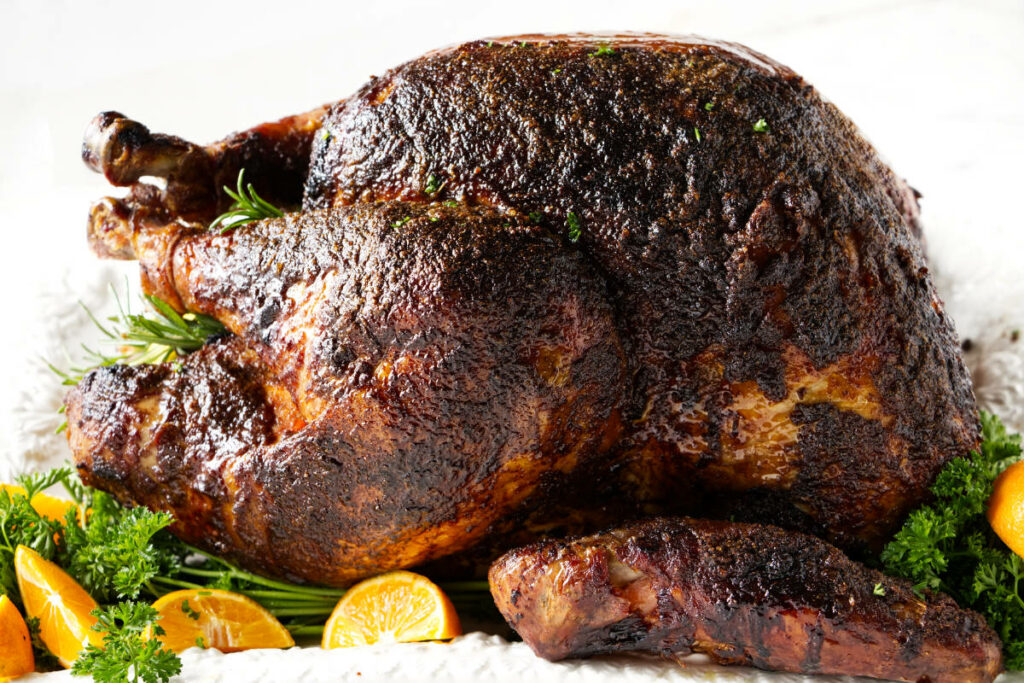
How Much Turkey Per Person
A good rule for buying a turkey is 1.25 to 1.5 pounds per person. However, if you have a small family, go for about 2 pounds per person. It is hard to find turkeys under 10 pounds, so if you need four servings or less, plan to have plenty of leftover smoked turkey. Ideas for leftovers are endless. Try a turkey pot pie, turkey soup, or burritos. If you don’t want a lot of leftovers, try our turkey breast recipe.
You are better off purchasing two turkeys if you have a larger crowd. Smaller turkeys cook more evenly and tend to be more tender. Larger birds are usually male turkeys and tend to be tough.
Use the table below as a guide for purchasing your turkey.
| Servings | Pounds of Turkey |
|---|---|
| 4 people | 8 to 10-pound turkey |
| 6 people | 10-pound turkey |
| 8 to 10 people | 12 to 14-pound turkey |
| 12 to 14 people | 16-pound turkey |
| 16 to 18 people | Two 13-pound turkeys |
| 20 to 24 people | Two 16-pound turkeys |
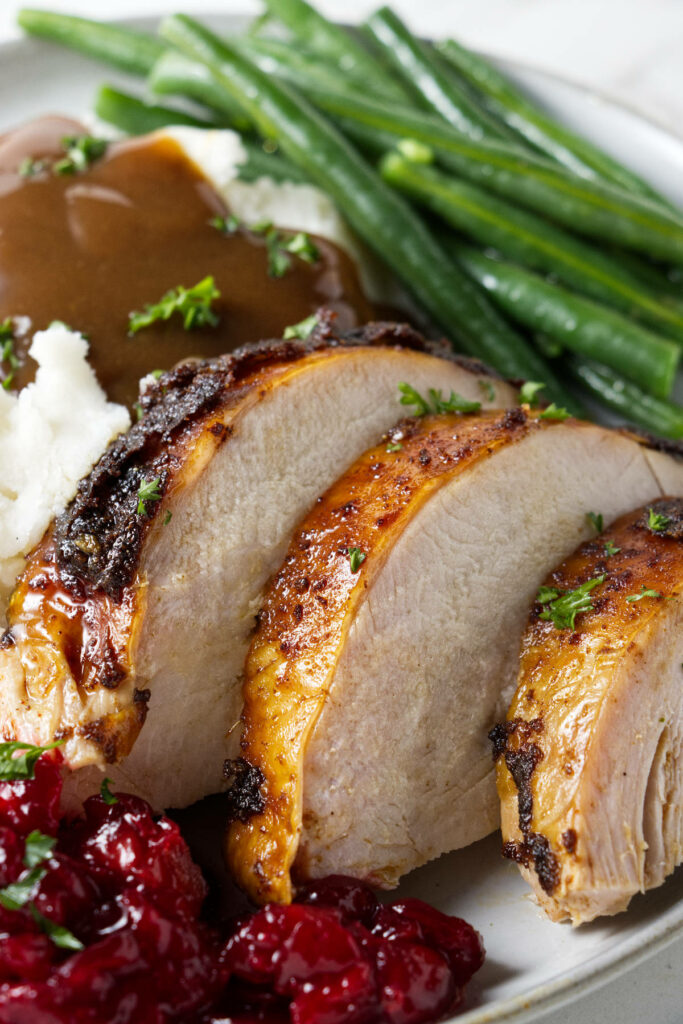
Our Traeger smoked turkey recipe will have you feeling like a holiday pro and will become one of your favorite ways to prepare turkey! This juicy, flavorful bird is perfect for your feast and sure to be a hit with family and friends.
Some Other Recipes We Are Sure You Will Love:
This recipe for baked turkey wings is delicious whether you’re serving it as a weekend dinner or game day appetizer. The wings are cooked in a tangy honey dijon sauce that gives them an extra depth of flavor.
Did you know you can cook a frozen turkey breast in the Instant Pot? This recipe makes it easy if you forget to thaw that turkey for dinner.
This is the best mushroom turkey meatloaf. Packed with savory goodies like finely chopped mushrooms, breadcrumbs, and rolled oats, the combination results in a tender meatloaf that’s full of flavor.
Pin this now to find it later!
Pin It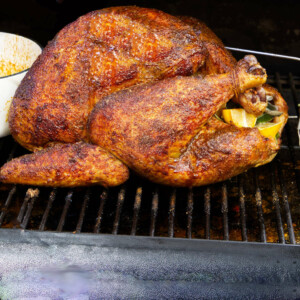
Traeger Smoked Turkey
If you make this recipe, please leave a star rating and comment.
Ingredients
- 1 whole turkey, 14 to 16 pounds
For the Dry brine
- 4 tablespoons BBQ seasoning dry rub
- 3 tablespoons Kosher salt
- 2 tablespoons brown sugar
For the Injection and Mop Sauce
- 7 tablespoons BBQ seasoning dry rub
- 1 cup apple cider vinegar
- 1 cup butter
- 1 cup olive oil
- ½ cup honey, or maple syrup
- 3 tablespoons Worcestershire sauce
- 1 tablespoon Tabasco
- ½ teaspoon Kosher salt, or 1 teaspoon table salt
Optional Aromatics to Stuff the Bird
- 1 onion, quartered
- 1 lemon, cut into quarters
- 4 sprigs fresh rosemary
- 2 to 3 sprigs Fresh thyme
- 1 to 2 bunches fresh sage
Instructions
- Pat the turkey dry with paper towels and loosen the skin over the breast and legs (slide an upside-down spoon under the skin to make this task easier).
- Place the turkey on a rimmed baking sheet or in a large casserole dish (make sure you use something that will hold in the juices that will seep out).
Dry Brine the Turkey
- Combine 4 tablespoons of BBQ seasoning and the Kosher salt in a small bowl.
- Sprinkle the dry brine into the cavity of the turkey, under the skin of the breast and legs, and all over the outside of the turkey.
- Bend the wings back and tuck them under the breast. Use butcher's twine to tie the legs together (this will help the turkey cook evenly on the pellet grill).
- Place the turkey uncovered in the refrigerator for 48 to 72 hours.
Inject the Turkey
- Preheat the pellet grill to 250°F.
- Combine the ingredients for the injection and mop sauce in a medium saucepan. Stir until the butter is melted. Remove the sauce from the heat and let it come to room temperature. Pour about half of the marinade into a separate dish and reserve it to use as a mop sauce.
- Draw up the remaining marinade into a turkey injector and slowly inject it in several places all over the turkey (see the notes if you have never injected a turkey before).
Smoke the Turkey
- Stuff the onion, lemon, and fresh herbs inside the cavity of the turkey. Insert a leave-in thermometer probe into the thickest part of the turkey breast.
- Place the turkey directly on the grill grates or place it in a pan if you want to collect the drippings. Close the lid and smoke the turkey for 1 hour, then start basting the bird with the reserved marinade every 30 to 45 minutes.
- Continue to smoke the turkey until the internal temperature reaches 140°F to 145°F then increase the temperature on the Traeger to 350°F.
- When the internal temperature reaches 160°F (4 to 6 hours*), transfer the turkey to a cutting board, cover it with aluminum foil and let it rest for 20 to 30 minutes. The internal temperature will continue to rise to 165°F or higher while it rests.
Notes
Injecting the turkey:
Some of the marinade will flow back out of the puncture holes that you inject into the turkey. Keep the turkey on a tray to collect the juices. Push the needle down to the bone and get the injection between the meat and the bone. Next, pull the needle up slightly and slowly inject it directly into the meat. If you have to re-load the turkey injector, try to use the same injection hole to finish injecting that area before poking a new hole. Try to use the same injection hole and angle the needle in 5 or 6 different directions and slowly lift the needle out as you inject the marinade. After you inject the marinade in one area, make another puncture hole several inches from the first and repeat the process. Use the length of the needle as your guide to measure the distance between puncture holes.Nutrition
Nutrition information is automatically calculated, so should only be used as an approximation.
 Like this recipe? Rate & comment below!
Like this recipe? Rate & comment below!Originally published on November 23, 2015.

